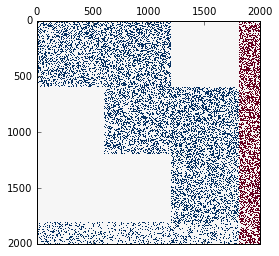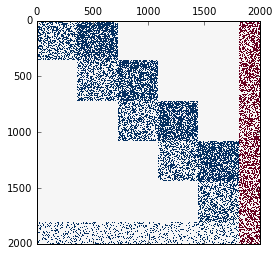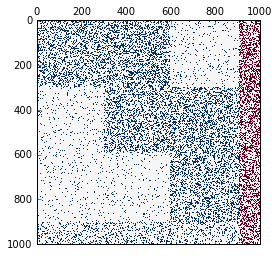Quickstart¶
This tutorial provides a brief overview over the basic functionality of this package.
Matplotlib is imported for visualization
import matplotlib.pyplot as plt
Network generation¶
The layered model can be imported form the connectome.model package
from connectome.model import LL
The parameters of a model can be pre-defined
ll = LL(nr_neurons=2000, inh_ratio=.1,
p_exc=.2, p_inh=.5, reciprocity_exc=.2)
ll
<LL nr_neurons=2000, p_exc=0.2, reciprocity_exc=0.2, inh_ratio=0.1, p_inh=0.5, nr_exc_subpopulations=∅>
A network with three layers can now be generated
network = ll(nr_exc_subpopulations=3)
network
<Network nr_exc=1800, nr_inh=200>
and visualized
plt.matshow(network.adjacency_matrix, cmap="RdBu");

Similarly, a network with five layers is generated and visualized, executing
network_5 = ll(nr_exc_subpopulations=5)
plt.matshow(network_5.adjacency_matrix, cmap="RdBu");

Please note that some parameters in the second call were still specified from the first call and therefore not passed again.
Network analysis¶
Summary statistics of a network are calculated with the help of the connectome.analysis package.
from connectome.analysis import RelativeCycleAnalysis
The number of cycles, relative to chance is computed with
cycle_analysis = RelativeCycleAnalysis(length=5)
cycle_analysis
<RelativeCycleAnalysis length=5, network=∅>
cycle_analysis(network=network)
{'relative_cycles_5': 0.19235267510727008}
The network contains less cycles of length 5 than expected by chance. A value above 1 indicates more cycles than expected by chance, a value below 1 indicates less cycles than expected by chance. The network’s reciprocity is calculated executing
from connectome.analysis import RelativeReciprocityEstimator
RelativeReciprocityEstimator(network=network)()
{'relative_reciprocity_ee': 1.0030832455128713,
'relative_reciprocity_ei': 0.9991984266639169,
'relative_reciprocity_ie': 0.999198426663917,
'relative_reciprocity_ii': 0.9993940697569447}
The reciprocity obtained here, is close to the one expected from a pairwise random network.
Noise¶
Noise models are implemented in the connectome.noise package
from connectome.noise import RemoveAddNoiseAndSubsample
Random removal of half of the network’s connections with simultaneous reshuffling of 20% of the connections is simulated via
noise = RemoveAddNoiseAndSubsample(subsampling_fraction=.5, fraction_remove_and_add=.2)
noise
<RemoveAddNoiseAndSubsample subsampling_fraction=<InputChannel: subsampling_fraction=0.5>, network=<InputChannel: network=∅>, fraction_remove_and_add=<InputChannel: fraction_remove_and_add=0.2>>
noisy_network = noise(network=network)
noisy_network
<Network nr_exc=900, nr_inh=100>
This network has after perturbation only 1000 instead of 2000 neurons before.
plt.matshow(noisy_network.adjacency_matrix, cmap="RdBu");

Additionally, connections on off-diagonal blocks appear; these were generated by the shuffling procedure. The number of cycles is also altered:
cycle_analysis(network=noisy_network)
{'relative_cycles_5': 0.68771057755341169}
The perturbed network has more cycles than the noise free version (0.192, see above).
